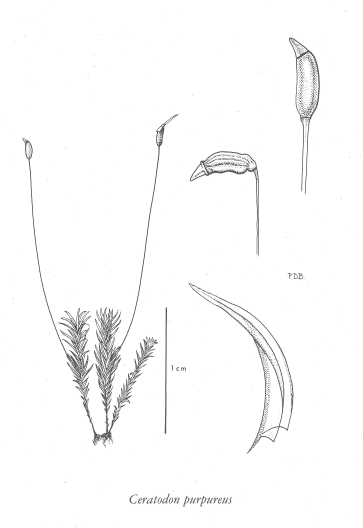Ceratodon purpureus (Hedw.) Brid.
fire-moss (ceratodon moss)
Ditrichaceae
Species Account Author: Wilf Schofield
Extracted from Some Common Mosses of BC
Introduction to the Bryophytes of BC
fire-moss (ceratodon moss)
Ditrichaceae
Species Account Author: Wilf Schofield
Extracted from Some Common Mosses of BC
Introduction to the Bryophytes of BC
Species Information
Species description:
The genus name based on the forked peristome teeth that resemble the horns of an animal. The species name referring to the redpurple seta and the frequently reddish-purple plants.
Reproduction:
Sporophytes common in spring when the deep red setae become conspicuous. Sporangia are glossy red-brown and 16-ribbed when mature, and oriented at right angles to the seta; the immature sporangium is smooth and erector suberect.
Distinguishing characteristics:
The sporophytes are usually present and form the most reliable feature for identification. The inclined, grooved, glossy red-brown sporangium and with a pronounced bulge at its base where it joins the seta, in combination with the dark green or reddish-brown leafy shoots, are characteristic.
Habit:
Forming dense, short turfs varying from dark green to wine-red, with erect, usually unbranched shoots, stems red-brown; leaves somewhat contorted when dry.
Similar Species:
Although Aulacomnium species possess grooved sporangia, these are light brown and not glossy, and taper gradually into the pale brown seta (dark red-brown in most specimens of Ceratodon). The leafy plants are pale yellow-green in Aulacomnium. Aulaconium androgynum, the species that might be mistaken for Ceratodon, usually grows on wood or humus and gemma-bearing shoots are often present. When without sporophytes Ceratodon can be confused with many genera, including Didymodon, Barbula and Bryoerythrophyllum. In these genera, sporangia are erect, cylindric, not grooved when ripe and the peristome teeth are often twisted. Sterile Catoscopium, when moist, show the leaves in three rows, especially near the stem apex, a feature never present in Ceratodon.
Illustration

If more than one illustration is available for a species (e.g., separate illustrations were provided for two subspecies) then links to the separate images will be provided below. Note that individual subspecies or varietal illustrations are not always available.
Illustration Source: Some Common Mosses of BC
Habitat and Range
Habitat
Sunny, usually sterile or disturbed soil, in areas that dry out rapidly. Common in urban areas, on stone or concrete walls, on road margins, even on rooftops. Sometimes forming extensive stands on roadside banks, most frequently at lower elevations but extending to alpine sites; infrequent in the wettest oceanic climates of the open coast. Range
World DistributionWidespread at all latitudes, especially in temperate or colder climates, from the high arctic to antarctic. At tropical latitudes more frequent in urban areas or at higher elevations.
Status Information
Synonyms
Synonyms and Alternate Names:
Ceratodon purpureus subsp. stenocarpus (Bruch & Schimp.) Dix.